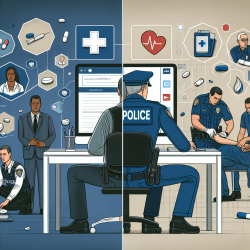Introduction
The opioid crisis continues to challenge communities across North America, with law enforcement officers frequently at the forefront of this battle. The research article "Evaluation of an Experimental Web-based Educational Module on Opioid-related Occupational Safety Among Police Officers" offers valuable insights into how online training can enhance the ability of police officers to respond effectively to opioid overdoses, while also ensuring their safety.
Research Overview
The study, known as the Opioids and Police Safety Study (OPS), aims to shift police practices related to people who use drugs (PWUD) by integrating public health promotion with occupational risk reduction (ORR). It evaluates a curriculum that supplements a web-based overdose response and naloxone training platform, GetNaloxoneNow.org (GNN). This approach is designed to improve public health outcomes and enhance occupational safety for law enforcement officers.
Key Findings and Implications
The research employs a randomized pragmatic trial design involving 300 active-duty police officers from counties with high overdose fatality rates. Officers are divided into two groups: one receiving the experimental training (GNN + OPS) and the other receiving a control training (GNN + COVID-19 ORR). The study's findings are expected to provide a deeper understanding of officers' experiences, knowledge, and perceptions, as well as the effectiveness of the training in changing key behavioral outcomes.
Key outcomes of the research include:
- Increased rates of officers carrying naloxone both on and off duty.
- Higher rates of overdose responses where naloxone is administered.
- Reduced rates of syringe confiscation.
- Improved information sharing with overdose survivors.
Practical Applications for Practitioners
For practitioners in the field of law enforcement and public health, the OPS study offers a blueprint for implementing effective training programs that align police practices with public health goals. By adopting the OPS curriculum, police departments can:
- Enhance officers' knowledge and skills in overdose response and naloxone administration.
- Reduce occupational risks associated with opioid-related duties.
- Foster a more supportive environment for PWUD, potentially reducing stigma and improving community relations.
Additionally, the study highlights the importance of continuous education and adaptation of training programs to address emerging challenges and misconceptions, such as those related to fentanyl exposure and Good Samaritan laws.
Encouragement for Further Research
While the OPS study provides a significant contribution to the field, it also underscores the need for ongoing research. Practitioners are encouraged to engage in further studies to explore the long-term impacts of such training programs and to identify additional strategies for integrating public health and law enforcement efforts.
Conclusion
The OPS study represents a critical step toward improving the safety and efficacy of law enforcement's response to the opioid crisis. By embracing evidence-based training and fostering collaboration between public health and law enforcement, communities can better address the complex challenges posed by opioid use and overdose.
To read the original research paper, please follow this link: Evaluation of an Experimental Web-based Educational Module on Opioid-related Occupational Safety Among Police Officers: Protocol for a Randomized Pragmatic Trial to Minimize Barriers to Overdose Response.










